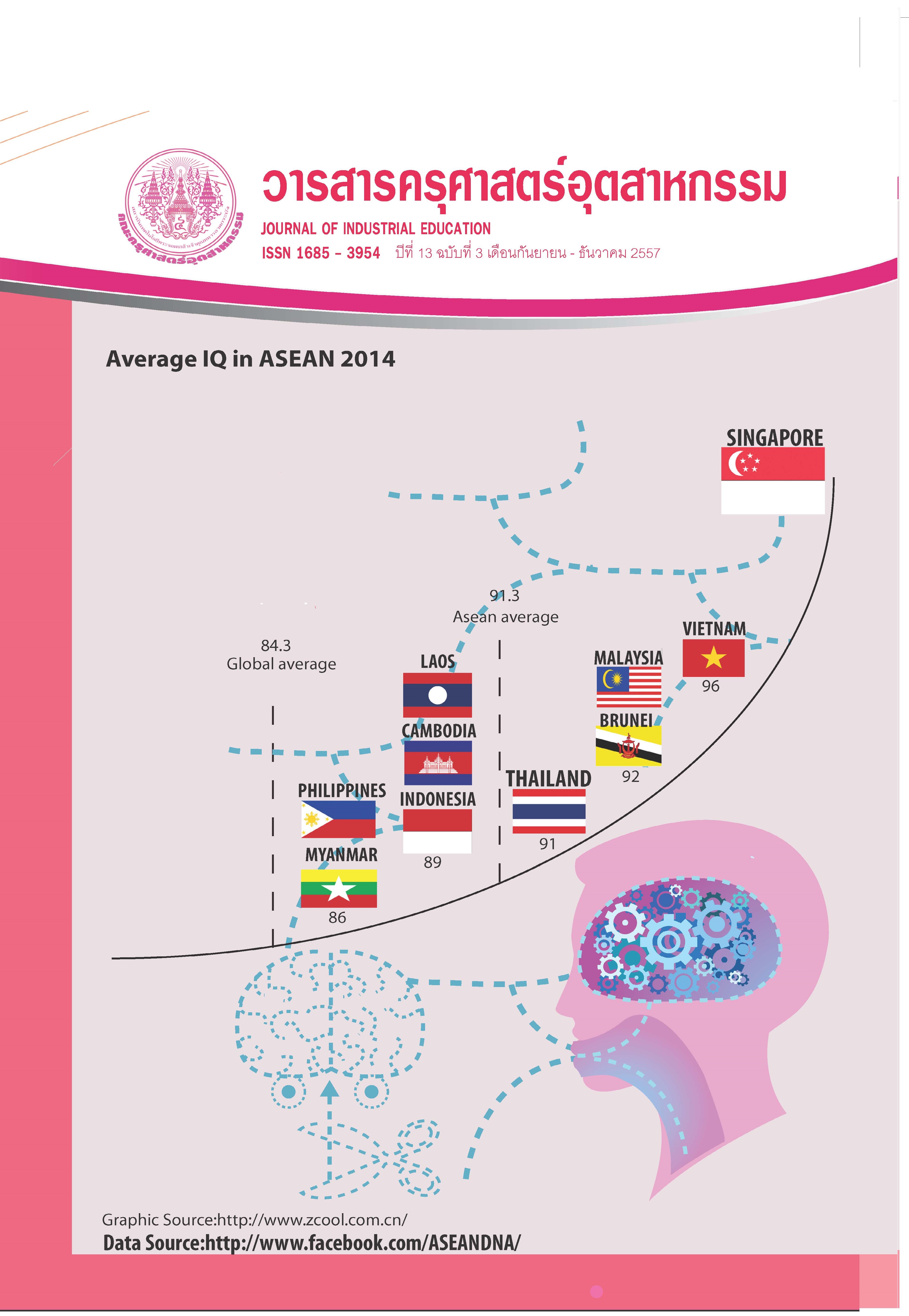Factor Analysis for Life Skills Development of Lower Secondary School Students
Keywords:
Factor Analysis, Life Skills Development, Instructional Model, Lower Secondary School Students, Bunditpatanasilpa Institute Ministry of CultureAbstract
The objectives of this research were 1) to study the life skills factors of lower secondary school students, 2) to develop of Instructional model for developing of life skills of lower secondary school students, and 3) to study the result of applying the instructional model to develop the life skills of Lower Secondary School Students. The research conducted as follows; phase 1 : to study the life skills factors of lower secondary school students, The samples of this research were 1,800 Lower Secondary School Students in 12 Colleges Dramatric Arts Bunditpatanasilpa Institute Ministry of Culture in the first semester of the academic year 2013 by a multi-stage random sampling. The instruments used to collect data were a interview form and a life skills test. Phase 2 : to develop of Instructional model, the result was examined of Instructional model by five experts. The appropriate model was good level. Phase 3 : to study the result of applying the instructional model, the experimental research methodology was carried out by the time-series design. The samples of this research were 59 Matthayomsuksa two student during the second semester of the academic year 2013 of Colleges Darmatric Arts Bunditpatanasilpa Institute Ministry of Culture by a multi-stage random sampling and a simple random sampling for divide into control group of 28 students and experiment group of 31 students. The period of study lasted 12 weeks. The data collected by the life skills test and a observation form. The statistics for data analysis were to find reliability with Cronbach’s alpha reliability coefficient and exploratory factor analysis by using Lisrel program Version 9.10. with activation code : 9F00-0DE7-2F4E-D2CF, mean, standard deviation and Repeated Measures One-Way ANOVA. The results were as follows : 1) Life Skills were composed of 4 factors as following : Thinking Skill, Mind Skill , Action Skill, Social Skill by The construct validity of structural model which analyzed by the exploratory factor analysis showed by the chi- square goodness of fit = 145.96, df = 75, p-value = 0.00, RMSEA= 0.023 GFI = 0.99, AGFI = 0.98, CFI= 0.99, RMR= 0.36, SRMR = 0.02 and CN = 1,312.31. 2) The Instructional model of life skills of Lower Secondary School Students composed of 4 factors as follows : 1. The theory/principle/concept of model 2. The objectives of model 3. The activities of model contained 6 sequential steps ; stimulation experience participation submission aggregation practical 4. Measurement and evaluation of model 3) The students who learned by this Instructional model of the life skills of lower secondary school students had higher in Life Skills, Social Skill than the students who learned by the traditional approach at .05 level (F = 620.31) and the behavior in Life Skills, Social Skill had higher than before the experiment at .05 level (F =6022.27).
References
[2] สำนักงานกองทุนสนับสนุนการสร้างเสริมสุขภาพ.(2548, มกราคม-กุมภาพันธ์). มติชน, น. 30.
[3] นพวรรณ วงศ์วิชัยวัฒน์. 2547. การพัฒนาทักษะชีวิตในการปฏิบัติให้รอดพ้นจากปัญหาสังคมโดยใช้การเรียนรู้แบบมีส่วนร่วม สำหรับนักเรียนชั้นประถมศึกษาปีที่ 6. วิทยานิพนธ์ปริญญาครุศาสตรมหาบัญฑิต สาขาวิชาประถมศึกษาบัณฑิตวิทยาลัย จุฬาลงกรณ์มหาวิยาลัย.
[4] ธนพัชร แก้วปฏิมา. 2547. การพัฒนาแบบวัดทักษะชีวิตสำหรับนักเรียนชั้นประถมศึกษาปีที่ 3–6. วิทยานิพนธ์ศึกษาศาสตรมหาบัณฑิต มหาวิทยาลัยเกษตรศาสตร์.
[5] สำนักงานคณะกรรมการการศึกษาขั้นพื้นฐาน.2551. ทักษะการดำรงชีวิตเสริมสร้างคุณภาพเด็กไทย. กรุงเทพฯ: วุฒิวัฒน์การพิมพ์.
[6] กมลวรรณ จีนหน่อ. 2553. การใช้กิจกรรมการแนะแนวเพื่อส่งเสริมทักษะชีวิตด้านการจัดการการเรียน เวลา. วิทยานิพนธ์ศึกษาศาสตร์มหาบัณฑิต สาขาวิชาจิตวิทยาการศึกษาและการแนะแนว มหาวิทยาลัยเชียงใหม่.
[7] World Health Organization. 1993.Life skills Education in Schools.Geneva: (n.p.)
[8] กรมสุขภาพจิต กระทรวงสาธารณสุข. 2545.รายงานการวิจัยเรื่องการสร้างแบบประเมินทักษะชีวิตและผลการส่งเสริมทักษะโดยใช้โรงเรียนพื้นฐาน. นนทบุรี: (ม.ป.พ.).
[9] วีระ นิยมวัน. เทคนิคการพัฒนาคน.[ออนไลน์]. ค้นเมื่อวันที่ 20 กันยายน 2549,จาก https://www.anamai.moph.go.th/advisor/tamra/.
[10] Mangrulkar; Leena, Whitman; Chery V , &Posner; Marc. 2001. Life skills Approach to Child and Adolescent Health Human Development. Washington, DC: Education Development Center.
[11] วัลลภ ปิยมโนธรรม. (2556, 4 มิถุนายน).องค์ประกอบทักษะชีวิตนักเรียนมัธยมศึกษาตอนต้น. [สัมภาษณ์โดย วารินท์พร ฟันเฟื่องฟู].
[12] เกรียงศักดิ์ เจริญวงศ์ศักดิ์. (2556, 7 มิถุนายน).องค์ประกอบทักษะชีวิตนักเรียนมัธยมศึกษาตอนต้น. [สัมภาษณ์โดย วารินท์พร ฟันเฟื่องฟู].
[13] ปวีณา หงสกุล. (2556, 17 มิถุนายน).องค์ประกอบทักษะชีวิตนักเรียนมัธยมศึกษาตอนต้น. [สัมภาษณ์โดย วารินท์พร ฟันเฟื่องฟู].
[14] คุ้มพงศ์ หนูบรรจง และจตุรงค์ เลาหะเพ็ญแสง.(2556). การศึกษาแนวทางออกแบบสภาพแวดล้อมเพื่อการเรียนรู้ระดับบัณฑิตศึกษาคณะครุศาสตร์อุตสาหกรรมสถาบันเทคโนโลยีพระจอมเกล้าเจ้าคุณทหารลาดกระบังเพื่อเตรียมความพร้อมสู่ประชาคมอาเซียน.วารสารครุศาสตร์อุตสาหกรรม, 12(3), น. 55-63.
[15] ชบา พันธุ์ศักดิ์. 2550. ศึกษาการพัฒนารูปแบบการเรียนการสอนเชิงประสบการณ์และการเรียนรู้แบบร่วมมือโดยการร่วมงานอย่างร่วมความรู้สึกระหว่างผู้ปกครองและครูเพื่อเสริมสร้างทักษะชีวิตสำหรับเด็กปฐมวัย. วิทยานิพนธ์ครุศาสตรดุษฎีบัณฑิต สาขาวิชาการศึกษาปฐมวัย จุฬาลงกรณ์มหาวิทยาลัย.
[16] ทิศนา แขมมณี. 2554. ศาสตร์การสอน.พิมพ์ครั้งที่14. กรุงเทพฯ: จุฬาลงกรณ์มหาวิทยาลัย.
Downloads
Published
How to Cite
Issue
Section
License
"The opinions and contents including the words in papers are responsibility by the authors."
"ข้อคิดเห็น เนื้อหา รวมทั้งการใช้ภาษาในบทความถือเป็นความรับผิดชอบของผู้เขียน"



